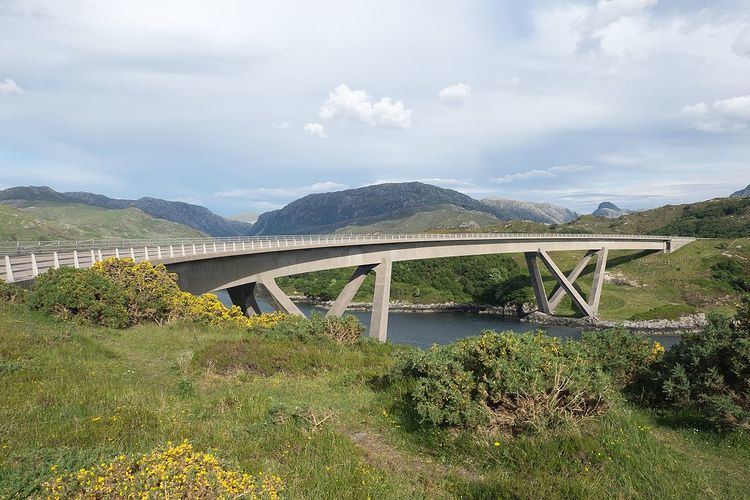Carries A894, one footway Longest span 79 metres Length 276 m Bridge type Box girder bridge | Total length 276 metres (902 feet) Opened July 1984 Location Kylestrome Material Concrete | |
 | ||
Address Kylesku Bridge, Lairg IV27 4HW, UK Similar Quinag, Box girder bridge, Ardvreck Castle, Eas a' Chual Aluinn, Laxford Bridge | ||
Aerial video of kylesku bridge
The Kylesku Bridge is a distinctively curved concrete box girder bridge in north-west Scotland that crosses the Loch a' Chàirn Bhàin in Sutherland.
Contents
Nc500 kylesku bridge
History
In June 1978 the Highland Regional Council asked Ove Arup & Partners Scotland to prepare a feasibility study for a bridge, in their capacity as consulting civil engineers, and was prepared by March 1979.
Construction for the approach roads, costing £4 million, began in summer 1981. Construction of the bridge began in August 1982, with Morrison Construction and Lehane Mackenzie and Shand the chief contractors.
It was constructed by building out the supporting legs and then lifting into place the central span, which had been constructed on land and then moved onto a barge by rail and weighed 640 tonnes (630 long tons; 710 short tons).
The cost of the bridge was £4 million, although was earlier budgeted at £2.75 million. The bridge opened to traffic in July 1984, and was formally opened by the Queen on 8 August 1984.
Geography
The bridge crosses water which is approximately 120 metres (390 ft) wide and up to 25 metres (82 ft) deep, leading to fast tidal currents. It replaced the ferry between Kylesku and Kylestrome, which was 400 metres to the east.
Design
The bridge is 275 metres (902 feet) long with a 79 metre long main span. The bridge deck is at a height of 24 metres (79 ft) above high water to provide navigation for ships.
The bridge deck is supported by V-shaped inclined piers, with eight inclined legs, in order to reduce the length of the main span. The lateral forces from each leg balance, so the total force on the foundations is vertically downwards. The spread of legs supports the bridge in winds which can exceed 100 miles per hour (160 km/h), and also loads resulting from the curvature of the bridge. There is no joint between the legs and the deck of the bridge, with the expansion joints and bearings being located at the abutments to facilitate straightforward maintenance. The legs are formed from reinforced concrete and the deck from prestressed concrete using cables tensioned at up to 52200 kN.
The bridge is designed to be sympathetic to the surrounding country, and the approaches were chosen to minimise changes to the landscape.
